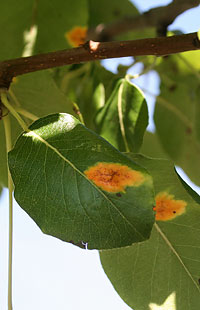|
Thuja 200C: Leaf curl in peaches
Red peach tree with signs of disease (reminiscent of large, ugly warts) on the leaves, 4 pellets dissolved in water, this solution used to water the roots – after a short time, normal development with copious peach harvest. (SD) Curly leaf disease on a peach tree
   I watered a peach tree badly affected by curly leaf disease for 4/5 weeks with Thuja 6D. About every three to four days, I made a solution of one capful (approximately 1 ml) diluted in 1 litre of water, and applied it directly and carefully round the trunk of the tree. I also gradually removed the affected leaves.
Since about one week, all new, fresh leaves are healthy and the peach is now growing normally again. The tree looks good and appears to have recovered well.
Stephanie L., Sachsenheim, Germany 2013
Thuja: Leaf curl on a peach tree
In her garden Ms Hemmerle has a peach tree, which was affected by leaf curl (also known as curly top). In 2012 about 1/6 of the leaves were infected and also the new leaves had the typical swollen red bulges.
In 2013 the tree initially had normal leaves until in June around half the leaves began to show the symptoms of leaf curl.
Ms Hemmerle sprayed the peach tree twice at an interval of 10 days, following the recommendations of Christiane Maute, with Thuja 30 C (6 pellets in 10 litres of water), tipping the remains of the spray solution into the root area of the tree. The affected leaves fell off gradually, with the new leaves developing well – in contrast to the previous year, they were completely healthy.
This year (2014) she will treat the tree preventively and then she will check whether leaf curl returns or not.
Elfie Hemmerich, Altenberg, Germany 2013
Thuja: pear trellis rust and monilia on a pear tree
The leaves of a pear tree were affected by pear trellis rust in spring. It was successfully treated with Gelsemium 200 C.
The
affected leaves died off and the new growth was healthy. A short while
later the tree was affected by monilia, causing the tips of the leaves
to shrivel.
Watering with Thuja 30 C
caused the monilia to disappear but then the pear trellis rust
reappeared. (As often happens with homeopathy: old complaints come back
again). A repeat application of Gelsemium 200 C
once again got rid of this problem. The harvest was over 30 kg of very
good pears; the tree looks great and is healthy. (Seminar report by
Christiane Maute)

 » Thuja occidentalis order » Thuja occidentalis order
Thuja 30C: Grubs on currants: 3 pellets in 10 liters water, applied once by watering, to combat grubs on currants – after one week, no more eaten-away areas could be seen. (SB)
Thuja 6D: Lyonetiidae moths: These little animals had always left marks on the leaves of my Iberis. The leaves looked like parchment paper and, if badly infested, the plants died. The first time I saw them this year, I watered the plants with Thuja 6D (5 ml /10 liters water) and the spell was broken.
 » Thuja occidentalis order » Thuja occidentalis order
Thuja 6D: House plant with spider mite infestation
Ponytail palm was badly infested with spider mite. Dead leaves were removed; but the new leaves were subsequently also found to be infested. The plant was treated once with Thuja 6, with the result that the spider mites disappeared after a few days.
6D: House plant with scale insect infestation
Watered many times with a solution of Thuja (amount and dosage unknown). Within 2 days, no more movement could be seen – after 14 days, all the scale insects had died. (SB)
200C: Leaf curl in peaches
Red peach tree with signs of disease (reminiscent of large, ugly warts) on the leaves, 4 pellets dissolved in water, this solution used to water the roots – after a short time, normal development with copious peach harvest. (SD)
30C: Grubs on currants: 3 pellets in 10 liters water, applied once by watering, to combat grubs on currants – after one week, no more eaten-away areas could be seen. (SB)
6D: Lyonetiidae moths: These little animals had always left marks on the leaves of my Iberis. The leaves looked like parchment paper and, if badly infested, the plants died. The first time I saw them this year, I watered the plants with Thuja 6D (5 ml /10 liters water) and the spell was broken.
 » Thuja occidentalis order » Thuja occidentalis order
|